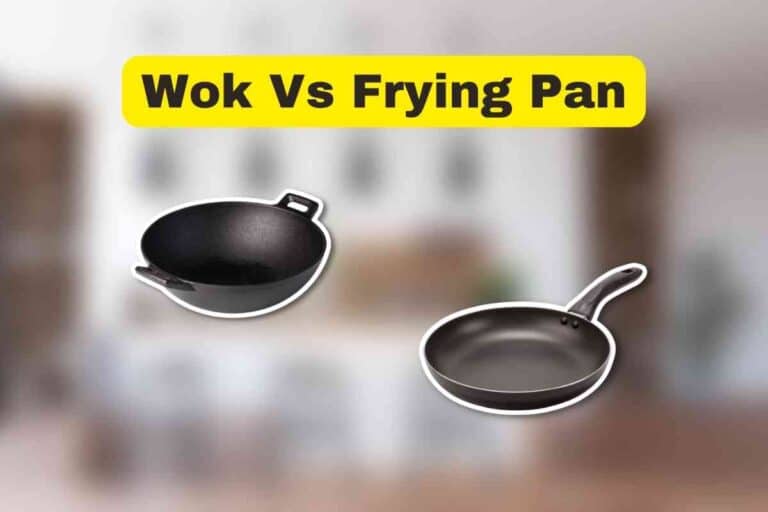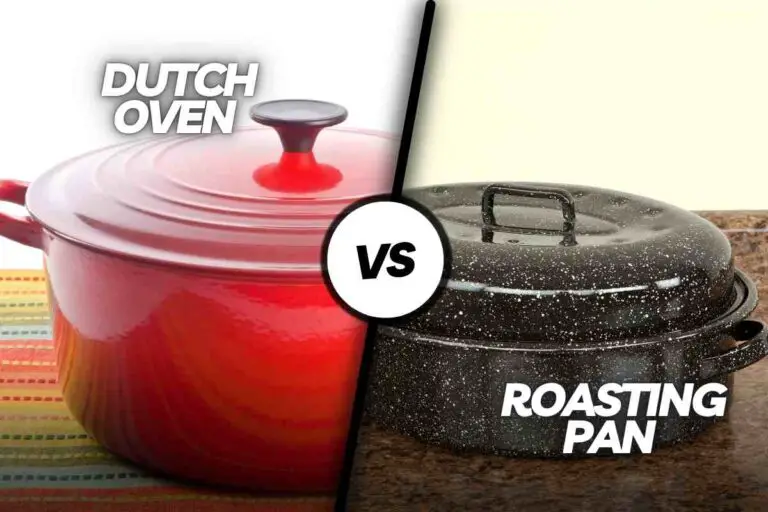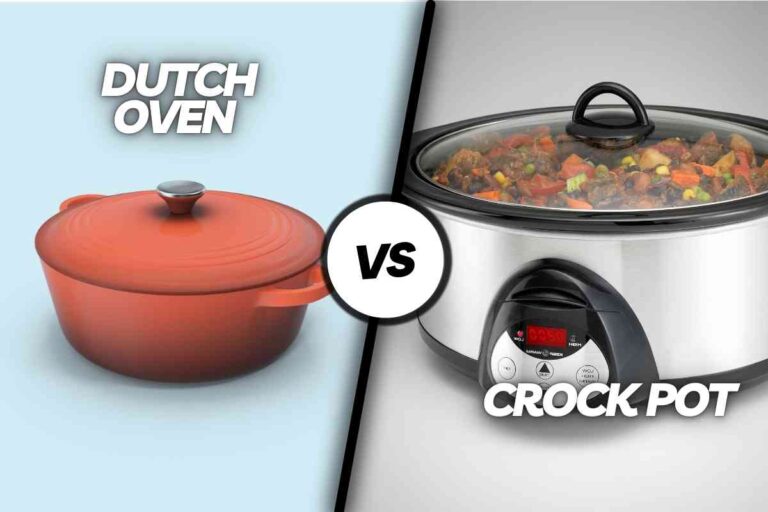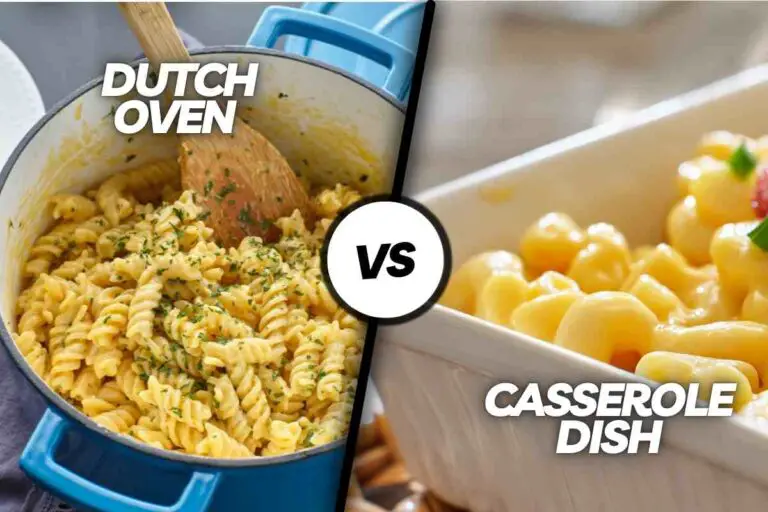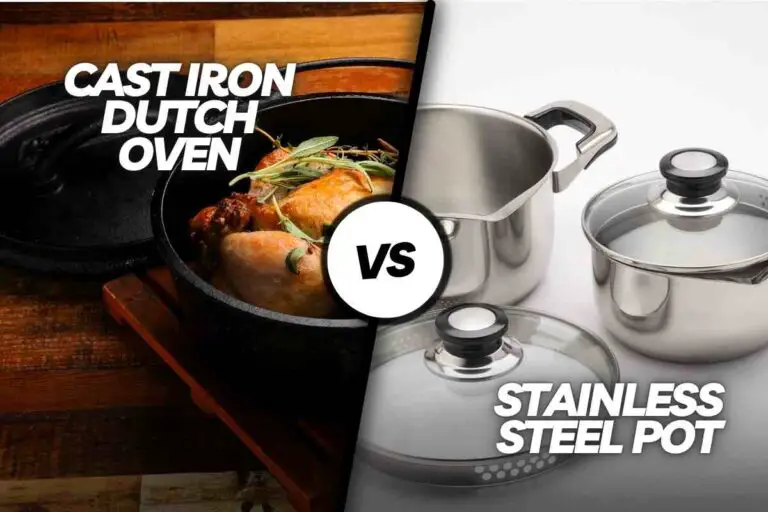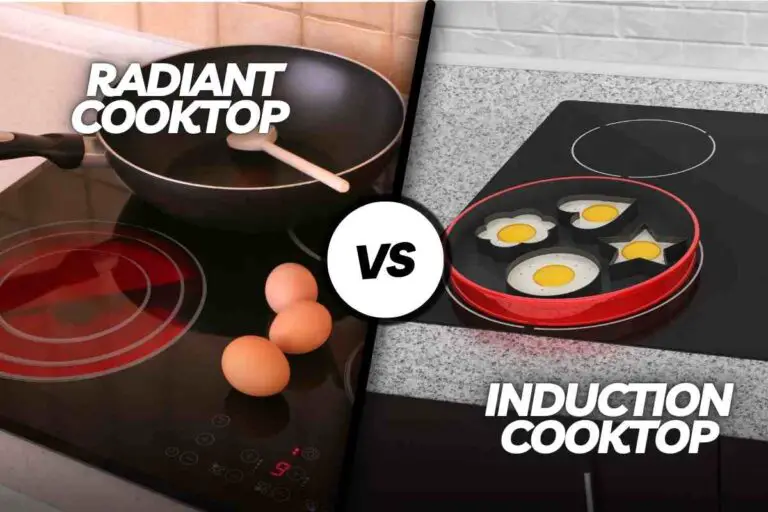Wok Vs Griddle – Choosing The Right Cooking Surface
If you are looking for the right cooking surface to cook your favorite meals, then you may be overwhelmed by all the options available.
Nowadays, almost every family has at least one wok or a griddle. A few of these are made of cast iron and look fancy.
Other than cooking, these cooking surfaces are also used to heat up food. So if you are looking for the right cooking surface for your kitchen, you will need to know the pros and cons of each type of cooking surface.
When deciding between a Wok vs Griddle, you will find that each has its own advantages and disadvantages.
In this blog, we will look at the differences between woks and griddles, including their pros and cons.
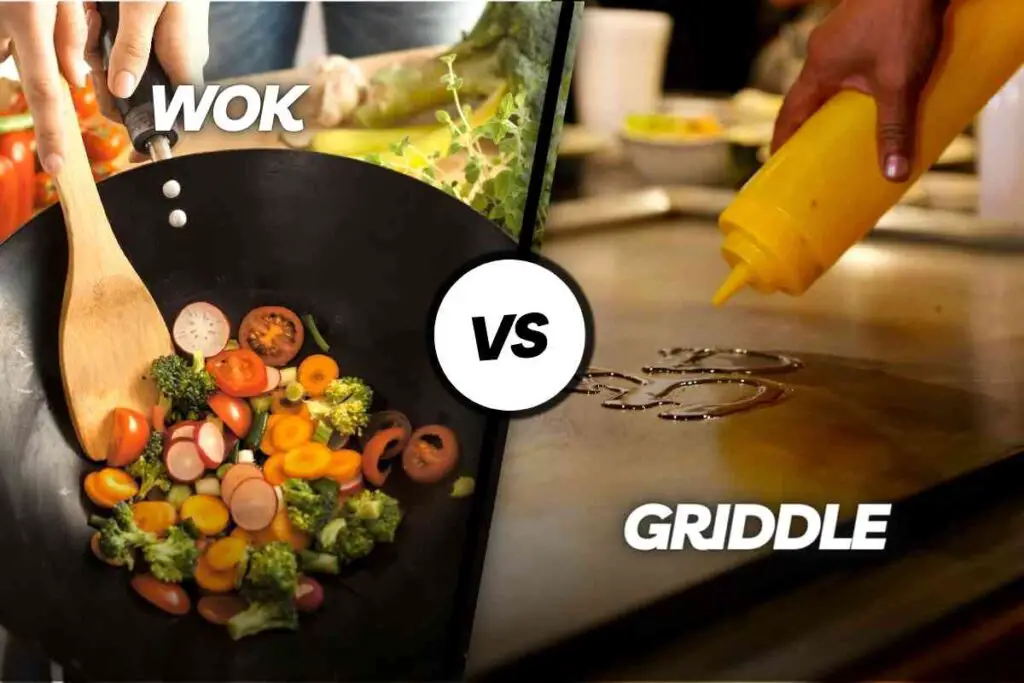
Wok Vs Griddle Side by Side Comparision
| Feature | Wok | Griddle |
|---|---|---|
| Shape | Typically has sloping sides and a round bottom, allowing for easy tossing and stirring of food. | Usually flat with a large cooking surface, ideal for cooking multiple items at once. |
| Cooking Style | Great for stir-frying, deep-frying, and quick cooking techniques. | Suitable for cooking pancakes, eggs, bacon, and grilling sandwiches or burgers. |
| Heat Distribution | Even heat distribution on the bottom and up the sides, making it excellent for high-heat cooking. | Even heat distribution across the entire cooking surface. |
| Cooking Capacity | Smaller cooking capacity, best for single or small servings. | Larger cooking area, ideal for preparing multiple servings at once. |
| Versatility | Can be used for a wide range of Asian and non-Asian dishes. | Primarily designed for breakfast items and flat-cooking techniques. |
| Oil Usage | Requires less oil due to the sloping sides, as the food can be cooked with minimal oil sliding to the bottom. | May require more oil or butter for certain dishes to prevent sticking. |
| Cleanup | Can be more challenging to clean due to the shape and potential food residue on the sides. | Easier to clean because of the flat cooking surface. |
| Portability | Lightweight and easy to handle, suitable for outdoor cooking over high heat sources like a gas stove or open flame. | Bulkier and typically used on a stovetop, grill, or flat cooking surface. |
| Common Dishes | Stir-fries, fried rice, noodle dishes, and deep-fried foods. | Pancakes, eggs, bacon, grilled sandwiches, and flatbreads. |
What Is Griddle?
A griddle is a type of grill with a flat surface for cooking. This type of grill is typically used for cooking food items such as pancakes, eggs, and bacon. A griddle grill typically has temperature control so that the user can adjust the heat as needed.
Griddles are large square frying pans with metal grates and work best at temperatures of 400degF (204degC). Because the surface is flat, a griddle is ideal for cooking granular and liquid-heavy foods.
These cooking surfaces can accommodate a variety of foods, and their versatility allows them to be used in almost any type of cooking setup.
Woks are made from carbon steel, a lightweight material that conducts heat well. Griddles are generally made from cast iron or aluminum.
What Is Wok?
A wok is typically used in Chinese cooking. It is round and has high sides that taper in towards the center. This allows the food to be cooked evenly and the chef to toss the food while cooking.
A wok is also ideal for stir-frying, allowing you to cook food quickly. Using the wrong utensil can result in food sticking and not cooking properly.
To get the most out of your wok, you’ll want to use a heavy cast-iron skillet or stainless steel pan.
You will also want to be prepared to work in batches and reheat the pan after each batch. You’ll also want to use a flat-bottomed wok rather than a standard skillet, as the wok’s flat bottom allows for better heat circulation.
You can also use oil flavorings like Sichuan peppercorns and hot chiles in your cooking. Just be sure to remove them from the oil before cooking.
Wok Vs Griddle: What’s The Difference?
A wok is a shallow, concave-shaped pan traditionally used in Chinese cooking. A griddle is a flat, usually rectangular, cooking surface used for pancakes, burgers, and grilled cheese sandwiches.
Shape
Wok: Woks typically have sloping sides and a round bottom. This shape allows for easy tossing and stirring of food during the cooking process. The high, sloping sides also help to keep food contained within the wok and prevent spillage.
Griddle: Griddles, on the other hand, have a flat and wide cooking surface with no sloping sides. This flat design is ideal for cooking multiple items at once, such as pancakes, eggs, and sandwiches, as it provides a large and even cooking area.
Cooking Style
Wok: Woks are excellent for stir-frying and other high-heat, quick-cooking techniques. They are designed to handle the intense heat required for these methods, making them perfect for dishes like stir-fries and deep-fried foods.
Griddle: Griddles are well-suited for cooking items that require a flat cooking surface, such as pancakes, eggs, bacon, and grilling sandwiches or burgers. They are primarily used for slower, flat-cooking techniques.
Heat Distribution
Wok: Woks are designed to distribute heat evenly across the bottom and up the sides. This even heat distribution is crucial for stir-frying and ensures that food cooks quickly and uniformly.
Griddle: Griddles are known for their consistent heat distribution across the entire cooking surface. This allows for even cooking of pancakes, eggs, and other items placed on the griddle.
Cooking Capacity
Wok: Woks generally have a smaller cooking capacity and are best suited for single or small servings due to their compact size.
Griddle: Griddles have a larger cooking area, making them ideal for preparing multiple servings at once. They can accommodate more food items simultaneously.
Versatility
Wok: Woks are versatile and can be used for a wide range of dishes, both Asian and non-Asian. They are not limited to stir-frying and can be used for deep-frying, braising, and more.
Griddle: Griddles are primarily designed for breakfast items and flat-cooking techniques. While they are versatile within their scope, they are not as diverse in terms of the types of dishes they can prepare compared to woks.
Oil Usage
Wok: Woks generally require less oil due to their sloping sides. The food can be cooked with minimal oil as it slides down to the bottom, making it suitable for healthier cooking methods.
Griddle: Griddles may require more oil or butter for certain dishes to prevent sticking since they have a flat cooking surface. The amount of oil used can vary depending on the recipe and the type of food being cooked.
Cleanup
Wok: Cleaning a wok can be more challenging due to its shape and the potential for food residue on the sides. However, with proper seasoning and care, it can become more non-stick and easier to clean over time.
Griddle: Griddles are typically easier to clean because of their flat cooking surface. Food debris is less likely to accumulate on the sides, and they are often easier to wipe clean after use.
Portability
Wok: Woks are lightweight and easy to handle. They are suitable for outdoor cooking over high heat sources like a gas stove or an open flame.
Griddle: Griddles are bulkier and are typically used on a stovetop, grill, or other flat cooking surfaces. They may not be as portable as woks.
Common Dishes
Wok: Common dishes prepared in a wok include stir-fries, fried rice, noodle dishes, and deep-fried foods. Woks are versatile and can handle a wide range of Asian and non-Asian cuisine.
Griddle: Common dishes cooked on a griddle include pancakes, eggs, bacon, grilled sandwiches, flatbreads, and similar items that benefit from a flat cooking surface. Griddles are often associated with breakfast foods but can be used for various other dishes as well.
Factors To Consider When Choosing Wok and Griddle
The most obvious difference between the two is the Nonstick coating, but you should also consider the seasoning, size, and price. Seasoning is important to prevent food from sticking to your pan and causing burns.
01. Nonstick coating
While the nonstick coating on woks and griddles may seem to be beneficial for cooking, they do pose a variety of health risks.
One major concern is PFOA, a chemical used to apply the coating to pans. Fortunately, newer nonstick pans do not use PFOA during the manufacturing process.
Nevertheless, using these pans only at low temperatures would be best. Also, avoid scratching the non-stick coating, as this can result in flakes of the coating in your food.
Another concern with non-stick coatings is that they can’t withstand high temperatures.
While they work well at lower temperatures, they’ll slowly wear down if temperatures exceed 450 or 500 degrees F. On the other hand, a seasoned wok is a more durable option than a new non-stick frying pan.
And because it’s prone to be hotter, it’s important to keep an eye on it while cooking. Using a wok requires that you keep moving the food to prevent burning.
02. Seasoning
If you’re cooking on a wok, you must be very careful while cleaning it. If you don’t clean it properly, you could damage it. To eliminate this problem, clean it with a sponge or wok brush.
It is important not to use soap or chemicals when cleaning a wok. You can also use pure boiling water to clean it. After cleaning it, you can use a sponge or wok brush to rub off food particles.
Be careful not to use ware washing chemicals, scouring pads, or sanitizers, which can remove the seasoning.
Seasoning a wok is a very simple process. You can use a wok spatula to move the oil around, which will help prevent the food from sticking and burning. You can also add more oil if necessary.
03. Size
When considering the size of a wok, consider the space it needs on your stovetop. For example, a 12-inch wok can accommodate 2 to 3 servings, whereas an eight-inch wok can accommodate up to eight.
In addition, consider how many people you intend to feed while deciding the size of your wok.
The wok’s flat bottom is best for electric ranges, although induction stoves can also be used with it.
If you have a glass-top range, be careful not to scratch the smooth surface. Also, you should avoid using non-stick woks on your electric range.
04. Price
If you’re looking for a quality cooking tool, you’re probably considering a wok or griddle. Both are great for many different cooking needs, and they’re both relatively inexpensive. But there are some differences between them.
The wok is typically made of carbon steel, which is ideal for stir-fries and sear-fries. In addition, carbon steel is strong, and its surface develops a nonstick patina when heated.
One brand that stands out is Aroma Housewares, which focuses on Asian cooking. The company’s woks are highly regarded, and it’s worth checking out their line.
Both the Professional and Basic Model are highly rated, and the Basic Model is the best-selling option in the category.
FAQs
Does Cooking in a Wok Make a Difference?
Yes, cooking in a wok makes a difference. A wok is a much smaller pan than a traditional skillet, so the heat spreads evenly and the food cooks quickly. Some types of cooking methods, like stir-frying, are still done in a wok.
Why Is Cooking in a Wok Better?
When cooking in a wok, the heat travels quickly from bottom to top. This makes the bottom of the wok hot and the uppermost parts of the wok cold. So, the food cooks faster and more evenly.
Can You Use a Wok on a Blackstone?
Yes, you can use a wok on a Blackstone griddle, as it provides a flat and even cooking surface suitable for wok cooking.
Does Cooking in a Wok Make a Difference?
Yes, cooking in a wok can make a significant difference in terms of heat distribution, speed, and flavor infusion, especially for stir-frying and certain Asian dishes.
Related Posts
Thank you for reading this post.
Choosing the right cooking surface is essential for creating delicious food. In this article, we compared the differences between the two types of cooking surfaces.
I hope this post, “Wok Vs Griddle,” is helpful for you.

